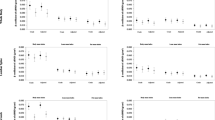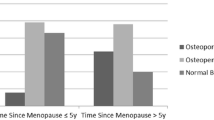Abstract
This study investigated the relative contribution of fat mass and lean mass to bone mineral density (BMD) in young and premenopausal healthy Chinese women. The study was performed in 282 young and premenopausal healthy women with regular menstrual cycles. The BMD at lumbar spine (L2–L4), total hip and total body, together with fat mass and lean mass were assessed by dual-energy X-ray absorptiometry (DXA); body height, weight, waist and hip circumference were also measured, and body mass index (BMI) and waist-hip ratio were calculated. Fat mass was a major determinant for BMI, BMI and lean mass were positively related to L2–L4, total hip and total body bone density (P<0.001 for all), lean mass was the only independent factor contributing to BMD at L2–L4 (standardized coefficient β=0.282, P<0.001), total hip (β=0.336, P<0.001) and total body (β=0.361, P<0.001) in multiple stepwise regression analysis. The correlation between BMI and BMD was improved after adjustment for fat mass, while decreased or even lost when lean mass was adjusted. These data suggested that in the Chinese population, lean mass is an important factor determining BMD in young and premenopausal women.
Similar content being viewed by others
References
Steigre P, Cummings SR, Black DM et al. (1992) Age-related decrements in bone mineral density in women over 65. J Bone Miner Res 6:625–632
Ravn P, Cizza G, Bjarnason NH et al. (1999) Low body mass index is an important risk factor for low bone mass and increased bone loss in early postmenopausal women. Early postmenopausal intervention Cohort (ERIC) study group. J Bone Miner Res 14:1622–1627
McGuigan FE, Murray L, Gallagher A et al. (2002) Genetic and environmental determinants of peak bone mass in young men and women. J Bone Miner Res 17:1273–1279
Felson DT, Zhang Y, Hannan MT et al. (1993) Effects of weight and body mass index on bone mineral density in men and women: Framingham Study. J Bone Miner Res 8:567–573
Hawker GA, Jamal SA, Ridout R et al. (2002) A clincial prediction rule to identify premenopausal women with low bone mass. Osteoporos Int 13:400–406
Munaisinghe RL, Rotea V, Edelson GW (2002) Association among age, height, weight, and body mass index with discordant regional bone mineral density. J Clin Densitom 5:369–373
Sirola J, Kroger H, Honkanen R et al. (2003) Risk factors associated with peri- and postmenopausal bone loss:does HRT prevent weight loss-related bone loss. Osteoporos Int 14:27–33
Lindsay RB, Hanson RL, Roumain J et al. (2001) Body mass index as a measure of adiposity in children and adolescents: relationship to adiposity by dual energy X-ray absorptiometry and to cardiovascular risk factors. J Clin Endocrinol Metab 86:4061–4067
Daniels SR, Khoury PR, Morrison JA (1997) The utility of body mass index as a measure of body fatness in children and adolescents: differences by race and gender. Pediatrics 99:507–526
Reid IR, Plank LD, and Evans MC (1992) Fat mass is an important determinant of whole body bone density in premenopausal women but not in men. J Clin Endocrinol Metab 75:779–782
Bedogni G, Mussi C, Malavolti M et al. (2002) Relationship between body composition and bone mineral content in young and elderly women. Ann Hum Biol 29:559–565
Langendonck LV, Claessens AL, Lefevre J et al. (2002) Association between bone mineral density, body structure, and body composition in middle-aged men. Am J Human Biol 14:735–742
Kopelman PG (2000) Obesity as a medical problem. Nature 404:635–643
Ellis KJ (2000) Human body composition: in vivo methods. Physiol Rev 80:649–680
Wong WW, Hergenroeder AC, Stuff JE et al. (2002) Evaluating body fat in girls and female adolescents: advantages and disadvantages of dual-energy X-ray absorptiometry. Am J Clin Nutr 76:384–389
Ijuin M, Douchi T, Matsuo T et al. (2002) Difference in the effects of body composition on bone mineral density between pre- and postmenopausal women. Maturitas 43:239–244
Wu XP, Liao EY, Huang G et al. (2003) A comparison study of the reference curves of bone mineral density at different skeletal sites in Native Chinese, Japanese, and American Caucasian women. Calcif Tissue Int 73:122–132
Lin YC, Lybe BM, Weaver CM et al. (2003) Peak spine and femoral neck bone mass in young women. Bone 32:546–553
Winters KM, Snow CM (2000) Body composition predicts bone mineral density and balance in premenopausal women. J Womens Health Gend Based Med 9:865–872
Ferretti JL, Capozza RF, Cointry GR et al. (1998) Gender-related differences in the relationship between densitometric values of whole-body mineral content and lean body mass in humans between 2 and 87 years of age. Bone 22:683–690
Pietrobelli A, Faith MS, Wang J et al. (2002) Association of lean tissue and fat mass with bone mineral content in children and adolescents. Obes Res 10:56–60
Ilich-Ernst J, Brownbill RA, Ludemann MA et al. (2002) Critical factors for bone health in women across the age span: how important is muscle mass? Medscape Womens Health 7:2
Valdimarsson O, Kristinsson JO, Stefansson SO et al .(1999) Lean mass and physical activity as predictors of bone mineral density in 16–20-year old women. J Int Med 245:489–496
Young D, Hopper JL, Cacinnis RJ et al. (2001) Changes in body composition as determinants of longitudinal changes in bone mineral measures in 8- to 26-year-old female twins. Osteoporos Int 12:506–515
Aloia JF, Vaswani A, Ma RM et al. (1995) To what extent is bone mass determined by fat-free or fat mass? Am J Clin Nutr 61:1110–1114
Fox MX, Magaziner J, Hawkes WG et al. (2000) Loss of bone density and lean body mass after hip fracture. Osteoporos Int 11:31–35
Kirchengast S, Peterson B, Hauser G et al. (2001) Body composition characteristics are associated with the bone density of the proximal femur end in middle- and old-aged women and men. Maturitas 39:133–145
Weiler HA, Janzen L, Green K et al. (2000) Percent body fat and bone mass in healthy Canadian females 10–19 years of age. Bone 27:203–207
Jensen LB, Vestergaard P, Hermann AP et al. (2003) Hormone replacement therapy dissociates fat mass and bone mass, and tends to reduce weight gain in early postmenopausal women: a randomized controlled 5-year clinical trial of the Danish Osteoporosis Prevention Study. J Bone Miner Res 18:333–342
Nguyen TV, Howard GM, Kelly PJ et al. (1998) Bone mass, lean mass, and fat mass: same genes or same environments? Am J Epidemiol 147:3–16
Hopper JL, GreenRM, Nowson CA et al. (1998) Genetic, common environment, and individual specific components of variance for bone mineral density in 10- to 26-year-old females: a twin study. Am J Epidemiol 147:17–29
Finkelstein JS, Lee ML, Sowers M et al. (2002) Ethnic variation in bone density in premenopausal and early perimenopausal women: effects of anthropometric and lifestyle factors. J Clin Endocrinol Metab 87:3057–3067
McKay HA, Petit MA, Khan KM et al. (2002) Lifestyle determinants of bone mineral: a comparison between prepubertal Asian- and Caucasian-Canadian boys and girls. Calcif Tissue Int 66:320–324
Douchi T, Yamanoto S, Yoshimitsu N et al. (2002) Relative contribution of aging and menopause to changes in lean and fat mass in segmental regions. Maturitas 42:301–306
Reid IR (2002) Relationships among body mass, its components, and bone. Bone 31:547–555
Courteix D, Lespessailles E, Loiseau-Peres S et al. (1998) Lean tissue mass is a better predictor of bone mineral content and density than body weight in prepubertal girls. Rev Rheum Engl Ed 65:328–336
Author information
Authors and Affiliations
Corresponding author
Rights and permissions
About this article
Cite this article
Liu, JM., Zhao, HY., Ning, G. et al. Relationship between body composition and bone mineral density in healthy young and premenopausal Chinese women. Osteoporos Int 15, 238–242 (2004). https://doi.org/10.1007/s00198-003-1536-7
Received:
Accepted:
Published:
Issue Date:
DOI: https://doi.org/10.1007/s00198-003-1536-7




